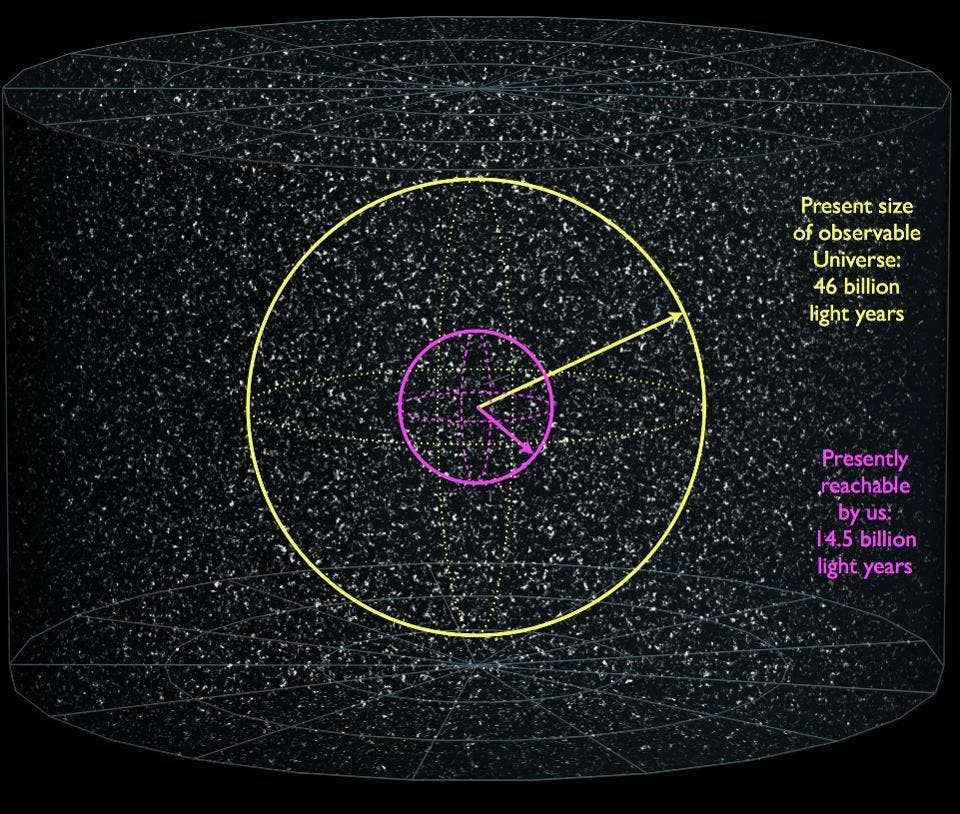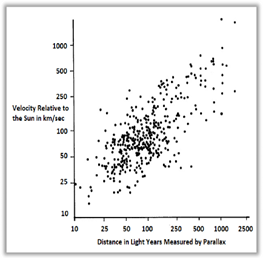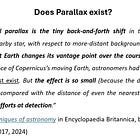Stellar Parallax, Light Years and incorrect dogma around time and distance. Another disproof of Relativity.
Many of the assumptions about light years, long ages, are based largely on parallax and rarely analysed. When you dissect them, you will find that the dogma has weak foundations.
“The acceptance of Riemannian space allows us to reject Einstein’s relativity and to keep all the ordinary ideas of time and all the ideas of Euclidean space out to a distance of a few light years. Astronomical space remains Euclidean for material bodies, but light is considered to travel in Riemannian space. In this way the time required for light to reach us from the most distant stars is only 15 years.”
Parry Moon and Domina Spencer, “Binary Stars and the Velocity of Light,” Journal of the Optical Society of America, Vol. 43, No. 8, August 1953, p. 635
Today the authors from the above quote would be tortured, tied to a stake and set alight. In their view the universe is much smaller than we are told and is a hall-of-mirror-effect, refracting and reimaging itself. Given that we don’t know the speed of light, they surmise a diameter of some 15 light years, or a fraction of the purported 93 million light year diameter claimed by ‘The Science’ (with some now saying it is more than 100 million light years in diameter). The assumptions behind ‘light years’ is rarely discussed.
We have previously discussed that ‘stellar parallax’ is the only known empirical method of determining the distance to a star or its ‘light year’ distance. It is assumed by everyone that this is ‘The Science’ and is accurate and beyond repute! Not so of course.1 Plenty of problems with stellar parallax exist and the claims that it supports heliocentricity for example are incorrect. These complaints would be applicable to the calculation of ‘light years’.
What is it?
A standard definition of a stellar parallax is: Parallax is the apparent displacement of an object because of a change in the observer's point of view. This concept is of course central to the theory of Relativity which has been well savaged in other posts. A parallax is used to measure the distance to a star. This is where the ’93 million miles’ distance to the Sun comes from. However, if you use Euclidean maths, you will derive a figure in the low millions at best. Why is that? The narrative’s answer is ‘stellar parallax’.
Bessel the Beloved
When the Church asked Galileo and his excitable friends for proof of Copernican theory, the stellar parallax was what they were after. Brahe’s (17th c.) helio-geo-centrism was premised in part, on this lack of evidentiary proof. It was not until Friedrich Bessel (1784–1846) that some purported proof for the parallax was offered, when in 1838, he observed a slight shift in the position of a nearby star (Cygnus) against the background of a more distant star. Bessel’s observation can be summarised below:
1. On a specific date, say January 1, Bessel viewed 2 stars, at the same time, in his telescope,
2. These were Cyni 61 (or Cygnus) and Vega, later determined to be 25 and 11 light years away respectively, (Bessel did not know this),
3. On January 1 Bessel might see that these 2 stars are vertically aligned in the telescope, one on top of the other,
4. Six months later on July 1, he takes another look at the same two stars, if parallax is demonstrated, he will see that the stars are not in a vertical alignment any longer,
5. Key assumption: Bessel assumes that the Earth has orbited in a counterclockwise direction, and the nearest star (Cygnus) appears to have shifted to the right,
6. Bessel could infer that in the interval of six months, he has looked at the two stars from two separate locations which are 186 million miles apart (the diameter of the Earth’s orbit),
7. Due to the distance travelled, the stars are now misaligned on July 1, but will be realigned on the following January 1.
Bessel had no way of knowing that Vega was further from the Earth than Cygnus. What he found was a ‘relative shift’. He compared the shifting of the 2 stars to the backdrop faraway, ‘fixed stars’. The ‘fixed stars’ would be the stars within the Milky Way galaxy which would provide the backdrop to Cygnus and Vega. The tiny apparent shift of 61 Cygni relative to this background is what allowed him to calculate its parallax. The slight shift was offered as proof that the Earth orbited the Sun.2

How small?
Bessel’s slight parallax calculation, is very, very, very, small. Even with modern equipment the purported parallax angle shift of a few identified stars is fractions of an arcsecond. An arcsecond is 1/3600th of a degree! Even for relatively nearby stars, the parallax angles are minuscule and barely measurable. Analogously:
· To convert an arcsecond into something we can understand, we can use radiansnb
· 1 radian is about 206,265 arcseconds
· We can convert radians to arcsecond: 1 x 10^-8 radians * 206,265 arcseconds/radian ≈ 2 arcseconds
· So, a human hair viewed from 10 km away, would subtend an angle of roughly 2 arcseconds
· Above we said that the parallax is a fraction of 1 arc second
· This means that we are viewing on Earth, an angle change equivalent to a subtended (enclosed) human hair from about 50 km….
nbA radian is a unit of angular measurement used to describe the size of an angle, based on the relationship between the radius of a circle and its circumference. A radian can be converted into an analogy we can comprehend, for example a subtended human hair at a distance.
Premised on the above infinitesimally small angle dislocation, Bessel inferred that he had proven the Earth’s motion around the Sun! For the Dearly Beloved of the Copernican church this was surely a divine act of genius!
Therefore some 200 years after asking Galileo for some proof, the Church finally got an answer. Of course, no such conclusion can be derived from Bessel’s rounding error observation. Parallax no more proves Copernicanism than the moon’s wobbly orbit around the Earth.
There is also an obvious tautology here. I need to assume 2 important things; first, that one star is closer to the Earth, and another further away (how do I prove this? more below); and second, I am already assuming that the Earth is orbiting and rotating around the Sun in a clockwise manner. I cannot, therefore, use the sequence above to prove that the Earth is orbiting and rotating around the Sun in a clockwise manner! In fact, the parallax angle is so miniscule, it is debatable if it even exists.
Modern Probes
The narrative is that the Gaia space telescope (from the ESA) can measure parallaxes for more than 1 billion stars, within the Milky Way galaxy. This is largely specious. The further away the star, the more difficult it is for a parallax to be observed. The closest stars to suggest a miniscule parallax are 61 Cygni, Alpha Centauri, Vega, Proxima Centauri, and Sirius. The claims are that these parallaxes are accurate to within 0.001 seconds of arc. In reality beyond 100 ‘light years’, it is hardly possible to measure an accurate parallax as shown above.
Negative parallax?
The ’billions of stars’ ‘proving parallax’ trumpeted by the bearers of ‘The Science’ sounds impressive, overwhelming, and is of course a ‘consensus’. However, the distribution of ‘positive parallax’ against ‘negative parallax’ is the same, roughly 29% and 26% respectively.
1. There are negative parallaxes (ie stars which shift to the left, not right, which would disprove Copernicanism),
2. In fact hundreds of thousands of negative stellar parallaxes have been viewed,
3. Geocentrism, or helio-geo-centrism can easily explain the apparent parallax movement of the few stars that are seen to move counter-clockwise over 6 or 12 months. So, we can’t say that ‘parallax’ proves Copernicanism, especially in light of negative parallax, even if we personally believe that the Copernican-cosmic model is the right one.
This phenomenon of a negative parallax has been observed since the advent of telescopes. In 1878, the famous Canadian astronomer Simon Newcomb briefly commented on the negative parallax issue, suggesting that ‘such a paradoxical result can arise only from errors of observation’. He was wrong of course. But anything to protect the narrative.
Negative parallax results from assuming that we on Earth are moving counterclockwise or left to right if viewed 2-dimensionally through space. ‘The Science’ cannot explain negative stellar parallax, so it prefers to ignore such observations or to dismiss them in light of the Gaia probe’s calculations of positive stellar parallax. This is not scientific.
Radial and Transverse velocity
Along with negative parallax there is the issue of velocity, namely radial velocity versus ‘proper motions’ or ‘transverse velocity’.
Radial Velocity: Velocity of an object (like a star) along the line of sight from the observer to the object, refers to how fast the object is moving directly towards or directly away from us.
Transverse Velocity (or ‘proper motion’): Velocity of an object perpendicular to the line of sight references how fast the object is moving sideways across our field of view.
Transverse or proper motion is the movement of a star independent from the rest of the star field. It is reasoned that stars with large transverse or proper motion are closer to Earth, than stars with little or no proper motion. Yet in a sample of stars with a large proper motion, 22.5% were measured by parallax to be at least ‘300 light years’ away from Earth.3 Therefore, if the parallax distance is correct, these particular stars are moving at tremendous speeds relative to the rest of the star field.
Many studies provide some evidence of a correlation between the measured parallax distance to the star and its proper motion velocity relative to the Sun. A typical graph of these movements is below:
The Big Bang would interpret the above to indicate that the radial velocity of stars, as measured by the Doppler Shift from a purportedly expanding universe, increases the greater the distance the star is from the Sun. But many of these same stars show transverse velocities (i.e., proper motion) in the 100 to 200 km/sec range, which far exceeds their radial velocity errors of unknown origin. Graphing the radial velocity against the transverse velocity produces the following contrast:
This cannot be explained by the ‘Big Bang’, which does not support the concept that the farther away a star is from Earth the more transverse velocity (or proper motion) it would have. But this is what the graph shows. Hence, the most logical interpretation of such data is that modern cosmology’s use of parallax to determine the distance to the stars from Earth is untrustworthy.4 This is rarely discussed of course.
Absolute Magnitude versus Radial Velocity
The same problem can be viewed when the absolute magnitude of a star is contrasted with its reported Doppler distance from Earth. ‘Absolute Magnitude’ is the apparent brightness the star would have if it was put at a distance from Earth of 32 light-years (or 10 parsecs). This means that if we ‘standardised’ the distance of stars we can try to calculate their real ‘luminosity’.
Based on the absolute magnitude of stars that we can see with the naked eye, the following graph shows that the farther away the star is from Earth, the brighter it is! This flatly contradicts the Big Bang expanding universe theory as well as the distances to the stars based on that model. Similar to radial velocity versus transverse velocity, the absolute magnitude versus radial velocity suggests a much smaller universe.5
Common sense tells us:
A distant star appearing brighter than closer stars means it has a higher intrinsic luminosity. It does not mean ‘long ages’.
It might be moving away or even toward us (radial velocity), or maybe sideways (transverse). We don’t know.
Luminosity and velocity are independent properties which means that ‘Redshift’, which is a light spectrum emission, has nothing do with ‘age’ or radial velocity away from us.
Our common sense is correct, that the brightness of a star does not dictate its speed away from Earth and cannot be used to claim, an infinitely expanding Earth, or even ‘light years’ distance.
‘Distant Starlight’ is not a problem
We can go further based on the above. The entire basis of the ‘parallax’ is the ‘distant starlight’ problem which in reality does not exist. Simply put, light speed in space is far different than on Earth due to many factors including but not limited to the aether and the obvious attraction of gravity. Assumptions inform the calculations of of starlight and distance, not empirical evidence.
For example, if we turn the Big Bang on its head (it is certainly wrong as many posts here outline) and move from Black Holes of singularity and beyond measurable gravity density to White Holes, there is nothing in ‘standard science’ to deny the claim that if the creative genesis of the universe erupted from a White Hole (the Big Bang postulates this), than the ‘escape velocity’ of matter and space, along with light speed and time as we understand it would be incomprehensibly and incalculably faster and younger. This means that cosmic time is vastly inflated and our understanding of light speed and light years is completely wrong.
Bottom Line
This post has outlined some issues with Einstein’s ‘Relativity’ and the generally agreed size of the Universe (93 million light years in diameter) and how stars are interpreted within that model – namely their age and distance. There are plenty of issues with using stellar parallax and associated assumptions to justify Einstotle’s philosophy and the ‘Big Bang’, and the accepted narrative that the universe is expanding and that stars are moving away from us at high speeds. Einstein originally calculated a static and reasonably small universe, but was coerced into changing his position based on Hubble’s work (which is wrong).
Modern probes, negative parallax, radial and transverse velocity do not support the current assumptions of stellar aberration, the construction of the universe, nor light year distance calculations. Given that we don’t really know the speed of light, and that Euclidean mathematics does not support the calculated distances to planets in our own solar system, it is self-evident that much of cosmological dogma around the principles which support the Big Bang narrative are clearly incorrect and in need of remediation. But this is rarely pursued.
Maybe the authors quoted at the beginning are right and the universe is smaller and far different than we are told. Imagine the impact on ‘The Science’ if that was indeed our reality. In any event, these are just more proofs that Relativity is invalid.
All hail.
==
1 A prime example of this difficult is the star Betelgeuse in the constellation Orion. See “A New VLA-Hipparcos Distance to Betelgeuse and its Implications,” Graham M. Harper, Alexander Brown, and Edward F. Guinan; The Astronomical Journal, 135:1430–1440, 2008 April, stating, “The distance to the M supergiant Betelgeuse is poorly known, with the Hipparcos parallax having a significant uncertainty” (http://iopscience.iop.org/1538- 3881/135/4/1430/pdf/aj_135_4_1430.pdf
2 Terence Dickinson and Alan Dyer, The Backyard Astronomer's Guide, 2024.
3 Based on parallax and proper motions measured for 276 faint stars by the U.S. Naval Observatory, Washington, DC, as cited in The Deceptive Universe by Jerrold Thacker, 1983, pp. 78-79.
4Ibid
5Popov, L., 2013, “Newtonian-Machian analysis of Neo-tychonian model of planetary motions,” Eur. J. Phys., 34, 383
Ostlie, D. A., and Carrol, B. W., 2007, An Introduction to Modern Stellar Astrophysics, 2nd ed., San Francisco: Addison Wesley
Barbour, J., 2010, “The definition of Mach’s principle,” arXiv:1007.3368
Parry Moon and Domina Spencer, “Binary Stars and the Velocity of Light,” Journal of the Optical Society of America, Vol. 43, No. 8, August 1953, p. 635)







